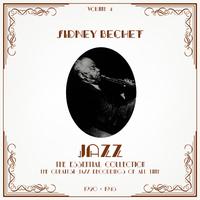
Jazz - The Essential Collection, Vol. 4
Although Sidney Bechet was among the greatest of all New Orleans musicians, the circumstnces of his career were such that it took a long time for the fact to be recognised. He was born in the Crescent City on May 14, 1897 and was virtually a child prodigy on the clarinet, sitting in with Freddie Keppard when still extremely young. As a Creole, he had the advantage of that race’s long tradition of fine playing on reed instruments in New Orleans, which descended from French practice, and by 1914-16, Bechet was touring with Clarence Williams. Also in 1916 he played with King Oliver, then went to Chicago and New York. In 1919 he was a member of Will Marion Cook’s Southern Syncopated Orchestra which toured Europe. There the orchestra was heard by Ernst Ansermet, the Swiss conductor and Stravinsky advocate. Ansermet wrote an article with strong emphasis on Bechet which was the first known piece of writing to take jazz seriously. Bechet liked Europe, especially Paris, though it was in London that he bought his first straight model soprano saxophone, and while he remained one of the great clarinettists in jazz, it was with the soprano saxophone that he was chiefly associated. Back in New York, Bechet made his first records in 1923-5 under the leadership of Clarence Williams and it was already clear that he was a magnificent improviser. Even the presence of Armstrong on Texas Moaner Blues and Cake Walking Babies does nothing to put him in the shade. In fact, it is clear that the chief elements of Bechet’s musical personality emerged early and remained constant, rather than developing through several phases as, say, Armstrong’s did. The vibrant emotional power of Bechet’s work in Kansas City Man or Wildcat Blues is as personal as that of his later music, as is the sheer fluency, although his mode of expression became richer and more varied with full maturity. The impact of his output was due largely to its combination of violence and sensuous beauty, a polarity met elsewhere in jazz yet rarely at such strength. Violence is communicated through the intensity of his execution and the virtuoso athleticism of phrases whose emphasis still leaves the impression that there is further power in reserve. Because of this, violence rarely swamps the almost sensual appeal of his wide vibrato and warm, full tone and inflections. In all this Bechet was aided by the character of the soprano saxophone – an instrument better suited to most of what he had to say than the clarinet – and by an almost inexhaustible melodic inventiveness. The violent aspect is typified by his soaring, triumphant playing on Maple Leaf Rag. The soprano’s exultant ferocity on Shake It And Break It or Coal Black Shine is unqiuely his, also. At his finest, Bechet conveys a passion, almost an ecstasy, that very few other jazz masters have paralleled and which aptly mirrors his dominating personality and restless, wandering life. This headlong intensity overbalances under exceedingly unfavourable circumstances only. Thus, during his final years in France, he often played with an unrelenting ferocity engendered by abysmal accompanists, the harsh accents and extreme vibrato obtruding at last on that wonderful flow of invention. Complementary to the extrovert emotion of his greatest moments was a tranquillity which involved no loss of musical tension. Lazy River, from his quartet dates with Muggsy Spanier, has a rightness and finish that must always be rare in improvised music. And the long-breathed phrases of Blue Horizon, one of Bechet’s three great clarinet recordings, underline that such unassertive beauty need not involve a weakening of musical nerve and sinew. It is the deeply moving Blues In Thirds, however, a 1940 trio performance with Earl Hines and Baby Dodds and one of the true classics of recorded jazz, that best embodies this side of Bechet’s music. Even earlier in his career than in Armstrong’s, it became evident that Bechet was a natural and inevitable soloist. This is nowhere more evident than in the overwhelming solo which closes Really The Blues. And indeed, despite his background in New Orleans jazz, he would always have trouble with conventional ensemble patterns. Thus some of his recordings, not included here, offer a confused playing together by the horns rather than genuine ensemble thinking. Yet he was capable of brilliant collective playing on his own terms and the counterpoint between clarinet and piano on Blues In Thirds demonstrates this. Still more remarkable is the session with Bunk Johnson, firstly because it was plainly organised according to the trumpeter’s ideas rather than Bechet’s and secondly because it represents a convincing reconciliation between two markedly different approaches to jazz. Milneberg Joys, Days Beyond Recall, Up In Sidney’s Flat and Lord, Let Me In The Lifeboat are full of closely-argued and equal-voiced counterpoint of rare expressive and musical richness between the two leaders plus Sandy Williams’s trombone. On Days Beyond Recall especially, the interplay rises to memorable intenisty, each part being most sensitively adjusted to the other two. A quite different example of Bechet’s flexibility is his performance of Ellington’s Old Man Blues. Yet Bechet’s own ideas are perhaps best represented by the session which, along with Old Man Blues, produced Shake It And Break It, Nobody Knows The Way I Feel Dis Morning and Wild Man Blues. Better than most others, these performances show that, as with Oliver, Morton and Armstrong, Bechet’s finest music is not New Orleans jazz but a highly personal development out of it, which is often truest to the spirit of that parent style when furthest from its letter. Also, Wild Man and Nobody Knows embody, more fully than many other performances, Bechet’s notably individual view, by turns majestic and intimate, of one of the main roots of his music, the blues. Practically as good, however, are Coal Black Shine, Slippin’ And Slidin’ and his third great clarinet vehicle, Egyptian Fantasy.
